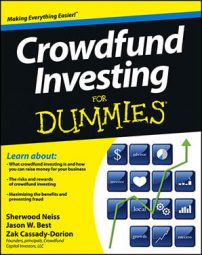With the advent of crowdfund investing, you have the classic two-sided market problem: How do you match demand and supply? How do you help businesses that need funding find willing investors who are looking to make investments in Main Street businesses or startups?
Prior to the passage of the JOBS Act in 2012, making such connections was difficult or even impossible. The laws governing how private businesses could seek capital from individual investors were written in 1933 and 1934 and were set up to protect people from scams and rip-off schemes. These laws created the Securities and Exchange Commission (SEC) and determined how stocks and securities were sold in the United States.
The JOBS Act permits private companies to generally solicit for equity and debt offerings, meaning they can publically advertise and discuss such offerings (subject to certain restrictions). Also, it makes crowdfund investing possible by enabling business owners to communicate with anyone via their social networks (such as LinkedIn, Facebook, and Twitter) to find potential investors for their business or startup ideas.
However, you must be aware that general solicitation and communication regarding equity and debt offerings can take place only in very specific ways that are regulated by the SEC. Therefore, businesses must make sure they’re clear on how to do this and what they need to do to protect themselves, their investors, and their customers from fraud, as well as to stay compliant with SEC regulations.
Create a business plan that involves crowdfund investing
One of the most important steps you can take before launching a crowdfund investing campaign is creating your business plan. You may have the world’s greatest business idea, but investors and lenders need to understand what you’re going to do with their money and how it will deliver a return on their investment; otherwise, you’ll never get off the ground.
A business plan forces you to get specific about your ideas, test your assumptions, and answer questions that potential investors will likely have. For investors, your business plan provides a standards-based way to evaluate your business versus others.
As you construct a business plan that includes crowdfund investment money, you need to take into account the time and process for raising money and, even more important, how you’ll communicate with your investors over time.
Do you have a strong online social network today? Do you have hundreds of connections on LinkedIn and Facebook and hundreds or thousands of followers on Twitter? If not, you need to build your online presence before you start trying to raise money online via crowdfund investing. The vast majority of investors in your business will be people who you know already; they’ll find out about your offering via social networks.
Post your campaign on an SEC-approved platform
The SEC, the Financial Industry Regulatory Authority (FINRA), the Crowdfunding Professional Association, and the Crowdfund Intermediary Regulatory Advocates are the key entities focused on creating rules that enable an orderly market to form for crowdfund investing. You’ll see these names throughout this book, and you should get familiar with each entity’s industry involvement.
You should use only an SEC-approved crowdfund investing funding portal (website) to list your equity or debt offering. (As a potential investor, you should shop for campaigns only via SEC-approved funding portals as well.) You must follow all SEC regulations and ensure that the funding platform you use is also registered with FINRA. Doing so protects your company, your investors, and the industry as a whole.
Identify investments of interest
Here are some key concepts that all potential investors must keep in mind when considering participating in this asset class:
Private businesses and startups are high-risk investments. These are high-risk investments. Could you see significant returns? Maybe. But you absolutely must proceed with caution.
You should create a portfolio of investments that has a mix of risk/return profiles based on your individual situation. Investments classified as high risk should make up less than 10 percent of your investable capital. You should consult with a qualified professional regarding your individual circumstances and planning.
Based on your income, you’re limited to how much you can invest each year in crowdfund investments. This limit helps ensure that no one can lose his entire savings on one bad investment.
You should plan to make small investments in at least ten crowdfund investing campaigns. Most professional investors (angel investors and venture capitalists) expect that out of ten investments in private companies and startups, seven will lose money, two will break even or have a small return, and one will have a significant return.
Are these numbers guaranteed? Absolutely not! You must do research on each potential investment, talk with people you trust, consider carefully, and then make small investments in people you know, products you use, businesses you trust, or entrepreneurs you believe in.
Crowdfund investing is an active form of investing. As an investor, you get to know these businesses much more personally than you know any public company you invest in. You can help the businesses with your expertise, but you must make sure you don’t become a nuisance to the business owner.

